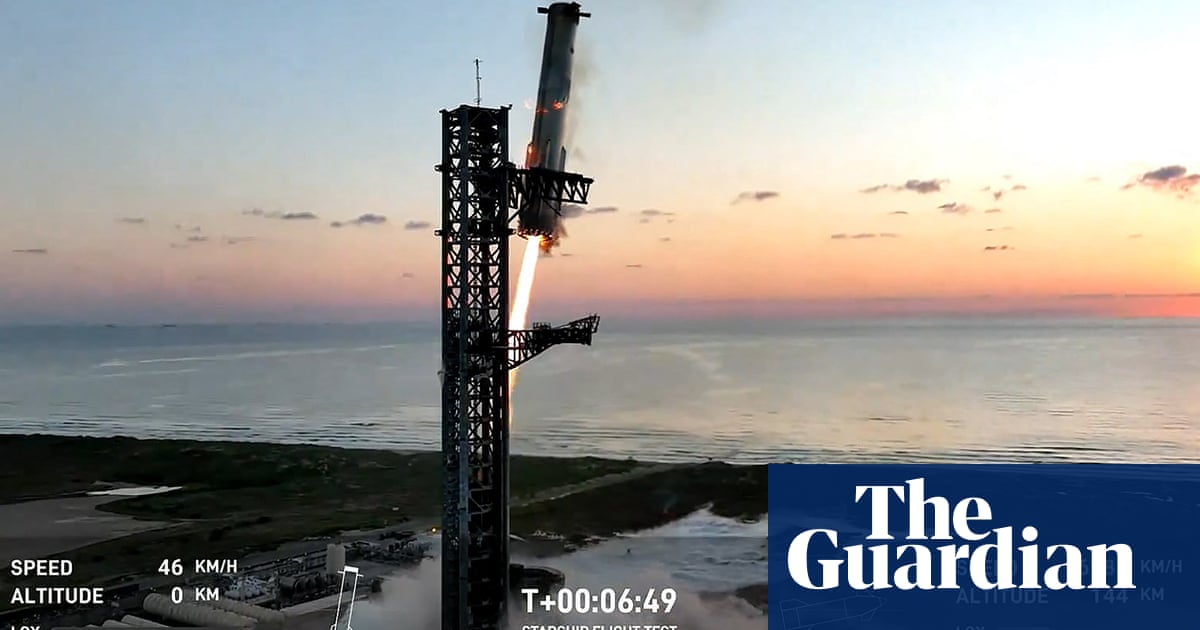Elon Musk’s SpaceX achieved a significant milestone on Sunday by catching the massive booster stage from its Starship rocket in a pair of robotic arms as it fell back to the company’s launchpad in southern Texas.
The historic feat, which drew praise from astronauts and space experts, topped a successful fifth test flight for the uncrewed Starship, which blasted off from the Boca Chica starbase at 7.25am local time (1325 BST) on Sunday.
As the rocket’s 71-metre (233ft) Super Heavy booster separated 40 miles (65km) above the Earth, the upper stage pushed on to an altitude of nearly 90 miles, looping around the planet at 17,000 mph before splashing down in the Indian Ocean as planned.
A bit on the why:
To SpaceX and Musk’s credit, whether the company’s second attempt at catching rockets goes as well as the first, some version of the massive ‘chopstick’ arms SpaceX is working on was likely going to be necessary just to rapidly turn around boosters and Starships – and do so regardless (within reason) of weather conditions. By replacing a tower crane with giant arms, SpaceX will hopefully be able to stack Starship on Super Heavy (and Super Heavy on the launch mount) even in the high winds that are almost always present on the South Texas Gulf Coast. If SpaceX can also reliably catch boosters with those arms, it could be a significant upgrade for the operations side of Starship reusability. For now, though, only time will tell.
https://www.teslarati.com/spacex-starship-launch-tower-mechazilla-arm-installed/
The video is really cool.
I find the video from afar really incredible too. You can see this giant, skyscraper sized rocket just falling down the sky at incredible speed.
https://x.com/i/status/1845444890764644694
PS: how can I link a twitter video without redirecting to the website ?
One way is to put the link into something like this. https://twittervideodownloader.com/download
I don’t think Twitter mirrors work any more unfortunately.
…I hope this doesn’t awaken anything in me…
Hold me in your giant metal arms and say sweet things to me…
Incredible control. You can see the engine flares vectoring the force to move the vehicle into place and keep it vertical.
deleted by creator
And they said it could be done
yeah chopstick catch was awesome. the explosion of the spaceship after “landing” in the water wasnt.
the more people think sending some people to mars makes us interplanetary, the less people take action on climate change.
just like you were duped with the boring company so there is no work on a railroad system.
go eat a cybertruck.
Mars transformation to be Earth-like requires 100,000 years. By then we’d either have ended climate change already or it would have ended us
So what are you doing with your life that allows you to judge others so easily?
Ban these ozone hole-generating rockets
We should ban cruise ships before shit that’s actually useful.
Both, preferably
It looks like SRBs and kerosene deplete ozone, but hydrogen doesn’t. I don’t see any research yet on methane effects, but it doesn’t produce a soot trail, so I’d guess it’d be more like hydrogen. Since starship uses methane and has an extremely efficient full flow engine, I think the effect on ozone would be extremely small.
That is satellite reentry, nothing to do with rocket launches. Building satellites out of something other than aluminum solves the issue, but even with mega consolations the effect is not super significant.
What do you think all these launches are putting up there? Starlink mega constellation satellites maybe?
Getting a rocket like this would probably allow for satellite to be built with materials other than aluminum because the cost goes down per launch since the rocket is reusable and the payload is so high the cargo doesn’t have to be built as light as possible.
In the process, we probably permanently damage the atmosphere.
Nope, this was a test launch.
How does that relate to what I said? Starship has not launched any payloads yet. Your original comment said this rocket should be banned because it depletes ozone. It doesn’t. You should say we should outlaw SRBs, soot trails, and aluminum satellite reentry, not ban starship or rockets in general.





